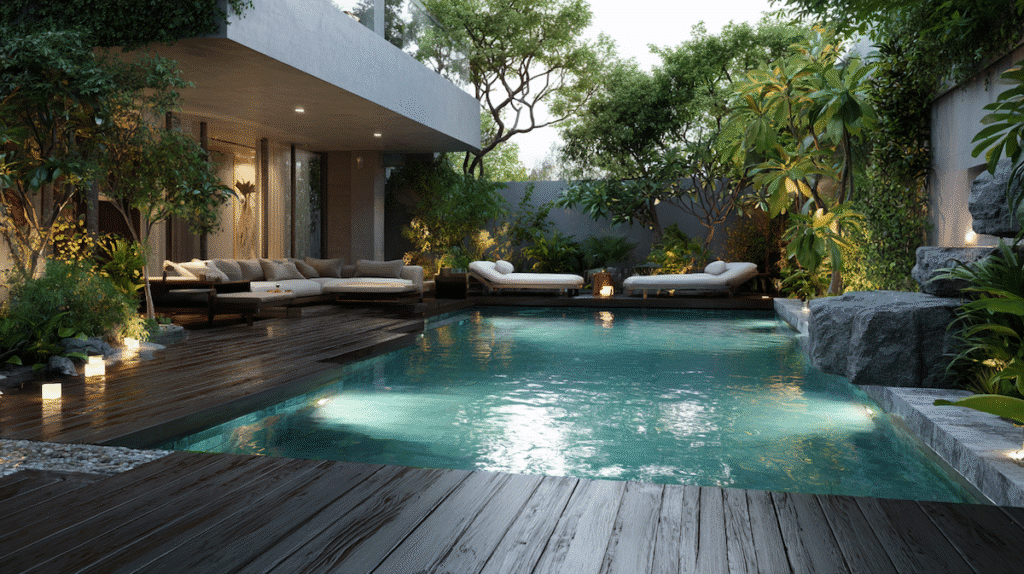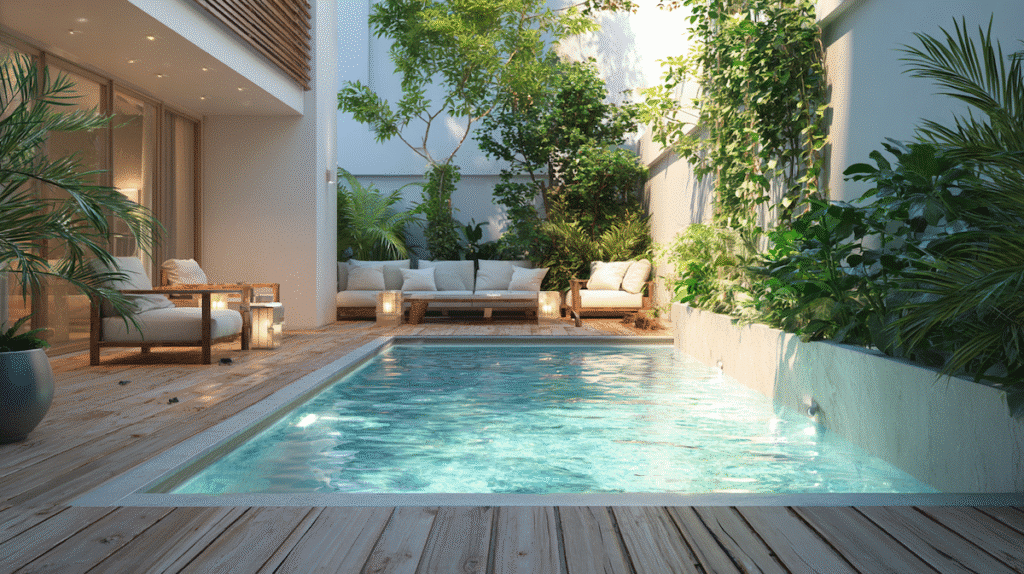When it comes to swimming pool trends, Melbourne stands out as a city where local conditions define what truly works. Unlike generic design trends seen elsewhere, Melbourne’s pool choices are shaped by its unique climate, the compact nature of many residential lots, and a growing commitment to sustainability.
The city’s hot, dry summers and cool, wet winters demand designs that not only enhance comfort but also minimise environmental impact. High urban density in many suburbs means space-efficient solutions are a must, while local flora — from Eucalyptus to Jacarandas — inspires a desire for natural integration. In Melbourne, pool trends are less about fleeting fashion and more about practical, climate-adapted design.
What Melbourne Homeowners Are Asking For in 2025
In 2025, pool design in Melbourne is driven by homeowner expectations rather than fleeting trends. These expectations reflect a shift towards practicality, sustainability, and integration with modern lifestyles.
“Low-maintenance, low-footprint” is the new luxury
Today’s Melbourne pool buyers value simplicity over extravagance. Compact pools that require less water, energy, and chemicals are seen as a luxury because they align with busy urban living and environmental responsibility. Features like self-cleaning systems and energy-efficient covers are increasingly requested.
Design continuity with indoor-outdoor architecture
Homeowners want pools that feel like a seamless extension of their living space. This means designs that echo the lines, colours, and materials of the house itself. Frameless glass barriers, matching paving, and integrated lighting are popular choices that enhance flow between indoor and outdoor areas.
Eco-Conscious Pool Building Is No Longer Optional
Environmental awareness is reshaping pool design across Melbourne. Sustainability is no longer a bonus — it’s an expectation built into the planning and construction of modern pools.

Solar and heat pump integrations adapted to Melbourne’s climate
Melbourne’s climate offers excellent conditions for solar pool heating. Homeowners increasingly choose solar panels or hybrid systems that pair solar with energy-efficient heat pumps, reducing reliance on gas or electric heaters. Ultimately, understanding how Melbourne’s climate is suitable for a pool with the right heating system is key to extending your swimming season while managing energy costs effectively.
Rise of mineral and ozone-based systems
Traditional chlorine pools are losing ground to alternatives that are gentler on swimmers and the environment. Mineral systems, using magnesium or potassium blends, and ozone-based purification systems are gaining popularity for their lower chemical use and softer water feel.
Regulatory pressures and water-saving technologies
Victorian water restrictions and sustainability targets are driving innovation in pool design. Features like rainwater harvesting for top-ups, backwash water recycling, and advanced filtration systems help homeowners stay compliant and reduce water waste.
Council incentives and planning rules: where it applies
Some Melbourne councils offer incentives for eco-friendly pool features, such as rainwater tanks or solar installations. Planning rules may also require water-saving measures or restrict pool sizes in drought-affected areas, adding further motivation to choose sustainable designs.
Trends in Small Yard Solutions (More Than Just “Plunge Pools”)
As Melbourne’s residential blocks get smaller, homeowners are seeking creative ways to enjoy a pool without sacrificing valuable outdoor living space. These solutions go well beyond the traditional plunge pool. While these design trends are inspiring, the practical process of how to install a pool on a narrow block in Melbourne’s inner suburbs involves unique construction challenges that require expert planning

Vertical edge designs and floating decks
Pools with vertical edges — where water meets decking or paving without a visible coping — create the illusion of space and offer a sleek, modern look. Floating decks over sections of the pool provide multi-use areas for relaxation, dining, or entertaining while maximising every square metre.
Combining spa + pool + garden in narrow blocks
Innovative designs now blend spas, pools, and landscaping into a single cohesive feature. On narrow lots, this integrated approach allows homeowners to enjoy the benefits of hydrotherapy, swimming, and green space, all in one compact footprint. Carefully planned planting softens hardscapes and enhances privacy.
Colours, Textures and Materials Seen Across Melbourne Suburbs
Visual trends in Melbourne’s pool designs reflect both aesthetic preferences and practical responses to the city’s climate. Homeowners are favouring light-coloured finishes that reduce heat absorption during hot summer months. Pale stone, sandy-toned concrete, and light ceramic tiles help keep pool surrounds cooler underfoot.
Textures matter too — especially in shaded areas where slip resistance is a priority. Non-slip surfaces like textured pavers and rough-finished tiles are common choices to improve safety without compromising style.
Material selection increasingly focuses on blending the pool with its natural environment. Designers and builders are choosing finishes that complement local vegetation, from the silvery greens of native Eucalyptus to the vibrant purples of Jacaranda trees. This integration helps pools feel like part of the landscape rather than imposed features.
Local Influence: What Builders Are Recommending Right Now
Melbourne’s pool builders offer practical advice based on years of experience with the city’s unique site conditions and climate. Their recommendations often help homeowners avoid costly mistakes and create pools that truly suit their property.
Feedback from contractors in Brighton and Camberwell
Builders in Brighton and Camberwell report growing demand for compact, multi-use pools that integrate seamlessly with landscaping. They highlight the importance of choosing durable materials that stand up to coastal winds near Brighton or the leafy debris common in Camberwell’s mature gardens.
Why some trends “don’t work” in Melbourne’s clay-based terrain
Many popular design ideas — such as expansive cantilevered decks or oversized infinity edges — can present structural challenges on Melbourne’s clay soils. Builders caution that these features may require additional engineering and can drive up costs. Instead, they often suggest simpler, smarter solutions that are better suited to local ground conditions.
Frequently Asked Questions (FAQ)
What kind of pool is best for narrow lots in Melbourne’s inner suburbs?
Compact lap pools, plunge pools with integrated spas, and custom L-shaped designs are popular for narrow lots. These options maximise swim space without overwhelming small backyards, and they can often be tailored to suit tricky block shapes common in Melbourne’s inner suburbs.
Are eco-pools really cheaper to run in Melbourne over time?
Yes — while eco-pools often involve higher upfront investment, features like solar heating, energy-efficient pumps, and advanced filtration typically reduce running costs over time. Melbourne’s climate allows for excellent solar performance, making these solutions even more cost-effective in the long run.
Do councils encourage sustainable pool design in Victoria?
Many councils actively promote sustainable pool design through planning policies and, in some cases, incentives. Features like rainwater tanks, solar heating, and water-saving technologies align with Victoria’s environmental goals and can simplify the approval process.
In Melbourne, pool trends are shaped far more by local conditions and homeowner priorities than by fleeting fashion. From eco-friendly technologies to space-smart designs, the most successful pools are those that respond thoughtfully to the city’s climate, terrain, and lifestyle.
Choosing a pool that aligns with these practical factors not only ensures long-term satisfaction but also contributes to sustainability and neighbourhood harmony. In short, the real trend in Melbourne is designing pools that fit the place — and the people who live there.
